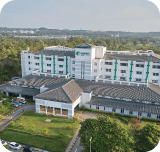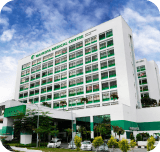Women’s Health
Breast Cancer Surgery – Current Practices and Future Trends
16 June 2021
Share

Screening and early detection
One of the best ways to detect breast cancer early is to go for regular screening. We encourage women above 40 years old to have annual breast screening, while those above 50 years old should do it every two years.
The preferred method is still the mammogram which uses low-dose X-rays to create images of the breast.
In most Asian women, however, the breast tissue tends to be very dense and hence conventional mammograms may miss small lesions. Nowadays, 3D mammograms (also known as digital breast tomosynthesis) can improve the accuracy by as much as 50%. Furthermore, ultrasound of the breasts can be added to a mammogram to improve the detection rate.
Preserving the breast
Lumpectomy, or removing the breast cancer together with a margin of healthy breast tissue, was conceived largely in response to the desire among patients to keep their breasts. Since the 1970s, clinical studies have confirmed that this option is safe and feasible. It has to be emphasised that lumpectomy has to be paired with radiotherapy so that cure rates similar to mastectomy can be achieved.
Recently, women with small breast sizes with relatively large tumours were often deemed unsuitable for lumpectomy, as such a procedure often left a large defect leading to a poor cosmetic outcome.
However, 3 recent developments have enabled more women to benefit from such a surgery. Firstly, the margins that are considered to be safe have dramatically reduced. Early studies demanded removing a full quarter of the breast (quadrantectomy), newer studies have reduced this margin over the years.
Today, it is agreed that a microscopically clear margin is all that is needed. To achieve this, communication and coordination between the surgeon and the pathologist is very important.
Surgery is often the first treatment that a breast cancer patient goes through, with a combination of chemotherapy, hormonal therapy and/or radiotherapy given after. The realisation is that giving chemotherapy first, known as neoadjuvant chemotherapy, before surgery can result in reducing the size of the cancer.
For certain subtypes of breast cancers such as Her2-positive and triple-negative tumours which are more sensitive to chemotherapy, the response can be so dramatic that the cancer has completely disappeared by the time of surgery.
By reversing the order of surgery and chemotherapy, we can give patients the option of keeping their breast, rather than undergoing a mastectomy if surgery was undertaken at the onset.
Finally, the emergence of new surgical techniques combining the principles of oncologic and plastic surgery resulted in a new field of oncoplastic surgery. A careful consideration of factors, such as location of the tumour, size and shape of the breast, scar placement etc., before surgery can lead to a better cosmetic outcome without any compromise to curing the cancer.
Such techniques involve filling the defect left after removing the cancer with adjacent healthy breast tissue or other nearby tissues such as fat or muscle. Another method called fat filling involves extracting fat from other parts of the body such as the abdomen or thighs and injecting it into the affected breast.
Constructing a new breast
For some patients, particularly those with extensive or multifocal disease, mastectomy remains the best surgical option. However, they no longer have to lose a breast completely.
Post-mastectomy breast construction is a proven technique and is increasingly popular. Early concerns of it being a longer and more complex procedure have restricted its use to young and healthy patients. Nowadays, the improved surgical expertise together with advances in postoperative care have made this a good option for virtually all breast cancer patients.
Briefly, the affected breast is removed by the breast surgeon through a small, well-concealed incision while preserving the overlying skin and nipple. The breast is then reconstructed by the plastic surgeon using either the patient’s own tissue, i.e. autologous flap, an implant, or both. Autologous muscle-based flaps are harvested from the back (latissimus dorsi flap) or abdomen (rectus abdominis flap).
More advanced, muscle-sparing techniques are also available, the most common being the DIEP (deep inferior epigastric perforators) flap. Performing breast reconstruction immediately after a mastectomy is the most convenient and cosmetically pleasing option.
For women who have genetic mutations, such as BRCA gene mutation, which predispose them to developing breast cancer, prophylactic or preventive bilateral mastectomy with reconstruction reduces the risk of breast cancer by over 90% while providing a high quality of life.
Sampling the lymph nodes
An integral component of breast cancer surgery involves checking the lymph nodes under the armpit, or axilla, to determine if the cancer has already spread.
In the past, this would mean that all the lymph nodes were removed during surgery, a procedure known as axillary lymph node dissection. This was done regardless of any evidence of spread at the time of diagnosis.
In retrospect, this was unnecessary in 80% of patients with early breast cancer as there was evidence of no spread to the lymph nodes on histological examination. Even worse, patients often are left with permanent arm swelling (lymphoedema), numbness, stiffness of the shoulder and risk damage to the nerves and blood vessels of the arm.
Sentinel lymph node biopsy, a highly selective and accurate method of checking the status of the axillary lymph nodes was first introduced in the 1990s. This revolutionary technique requires the surgeon to identify and remove only the lymph nodes that are the first to be involved in case of cancer spread, i.e. the ‘sentry’ or sentinel lymph nodes.
Only in cases where these lymph nodes were involved by cancer will an axillary lymph node dissection be necessary. It is no wonder that sentinel lymph node biopsy has quickly been adopted as the gold standard procedure for early breast cancer.
Since then, sentinel lymph node biopsy has been expanded further. For instance, in patients undergoing lumpectomy who have no more than 2 involved lymph nodes, an axillary lymph node dissection is not necessary as the radiation given after surgery is enough to minimise the chance of tumour recurrence.
Another example is the use of sentinel lymph node biopsy in patients with proven lymph node metastases at diagnosis, but showed excellent response to neoadjuvant chemotherapy.
Future of surgery…or the lack of it
In this age of disruptive innovation affecting every facet of our lives, the practice of medicine and surgery will not be spared. The current trend of ‘less is more’, reducing the extent of surgery while improving patient outcome, is relentless and quickening.
We are already witnessing the beginning of the end of surgery as a treatment option for breast cancer patients. 3 prominent examples provide a tantalising glimpse into a ‘surgery-free’ future.
Ongoing clinical trials on both sides of the Atlantic, namely the COMET and LORIS studies involve treating patients with hormone-sensitive, non-invasive or in-situ breast cancer with hormonal therapy alone.
Before these trials, there were already proponents of a more conservative approach to treating in-situ breast cancer, as the main purpose of treating such conditions is to prevent it from developing into an invasive cancer.
Still, others felt that such cancers were the result of overdiagnosis following widespread breast cancer screening. They argued that without screening, these indolent tumours would have remained undetected and never led to an adverse outcome.
As mentioned earlier, we now know some breast cancer subtypes are sensitive to chemotherapy, with complete responses increasingly possible, thanks to the advent of more effective drugs.
Currently, surgery is still considered mandatory to ensure that all remaining cancer cells, if any, are removed after chemotherapy. With improved methods of imaging and biopsy, early feasibility studies are ongoing to determine if any remaining cancer can be accurately tested after chemotherapy using minimally invasive biopsy techniques.
In cases where no residual cancer is detected, surgery could soon prove to be a thing of the past.
The third example examines if we can completely abandon any surgery for axillary lymph nodes. The ongoing SOUND clinical trial conducted in Italy hopes to prove that accurate preoperative ultrasound, with the use of fine needle biopsy of axillary lymph nodes if necessary, before surgery for early breast cancers can safely replace the need for sentinel lymph node biopsy. The findings of this study are expected to be announced in the next couple of years.
Conclusion
Surgery continues to be a critical step in the treatment journey of breast cancer patients. We are witnessing a trend towards performing smaller and better-timed surgeries to provide durable cures while minimising complications.
There is also increasing emphasis on optimising cosmetic outcomes which improve psychological well-being. Finally, surgery may be completely avoided in the future if current clinical trials prove successful.

The following article was written by Dr Ong Kong Wee, Visiting Senior Consultant, Breast Surgery at HMI Medical.



